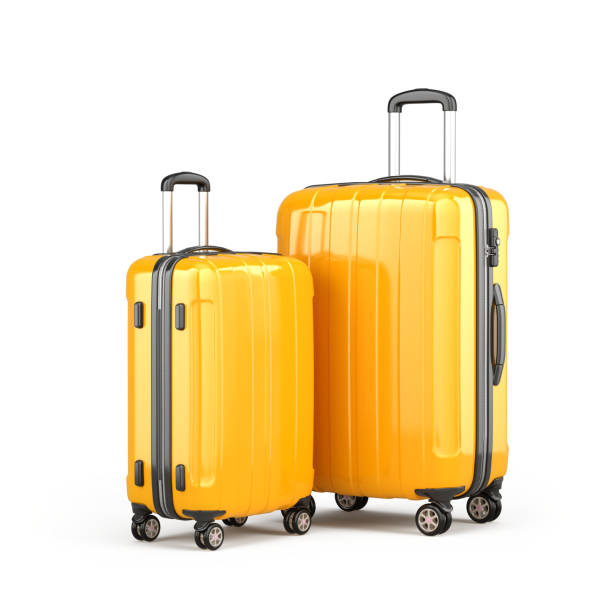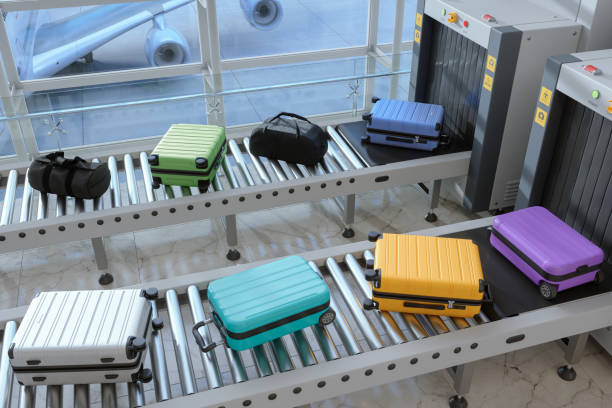여행 가방의 정확한 크기를 아는 것은 번거롭지 않은 여행에 중요합니다., 짧은 여행 또는 연장 휴가를 위해 포장하든. 항공사에는 엄격한 수하물 크기 제한이 있습니다, 그리고 그들을 초과하면 추가 수수료가 발생할 수 있습니다.
이 포괄적 인 가이드는 수하물 측정을 안내합니다., 항공사 제한 이해, 그리고 수하물 크기와 관련된 일반적인 질문에 대답합니다.
여행 가방을 측정하는 것이 중요한 이유?

초과 수하물 요금을 피하십시오
항공사는 기내 반입 및 점검 수하물 모두에 대한 엄격한 크기 및 중량 제한을 시행합니다.. 이 한도를 초과하면 수수료가 무한하거나 공항에서 재 포장을해야 할 수도 있습니다.. 사전에 가방을 측정함으로써, 항공사의 요구 사항을 충족하고 이러한 추가 요금을 피할 수 있습니다..
항공사 규정과의 호환성을 확인하십시오
다른 항공사는 수하물에 대한 크기 제한이 다양합니다. 이러한 차원에 익숙해지고 여행 가방 측정에 따라 더 부드러운 체크인 프로세스를 보장하고 가방이 거부되거나 추가 수수료가 부과 될 위험이 줄어 듭니다..
포장 효율을 최적화합니다
가방의 정확한 치수를 알면 더 효율적으로 포장 할 수 있습니다., 크기 제한 내에 머무르는 동안 공간을 최대화합니다. 확장 가능한 수하물을 사용할 때 특히 중요합니다, 오버 패킹은 허가 된 치수를 초과 할 수 있으므로.
여행 가방 측정을위한 단계별 가이드

높이를 측정하십시오
- 여행 가방을 똑바로 세우십시오
자연적인 직립 위치의 평평한 표면에 가방을 놓으십시오..
- 바퀴와 비 부패성 핸들을 포함하십시오
바닥에서 가장 높은 지점까지 측정하십시오, 바퀴와 고정 핸들을 설명하는지 확인하십시오, 항공사가이를 측정에 포함시킵니다.
- 측정을 기록하십시오
다양성을 위해 인치와 센티미터의 높이를 기록하십시오..
너비를 측정하십시오
- 여행 가방을 평평하게 놓으십시오
가장 넓은 부분에 액세스하기 위해 여행 가방을 뒤쪽에 배치하십시오..
- 가장 넓은 지점을 가로 질러 측정하십시오
측정 테이프를 한쪽에서 다른쪽으로 확장합니다., 측면 손잡이 또는 돌출부를 포함합니다.
- 너비를 문서화하십시오
이 측정을 정확하게 기록하십시오.
깊이를 측정하십시오 (두께)
- 여행 가방을 평평하게 유지하십시오
가방의 위치를 뒤쪽에 유지하십시오.
- 앞뒤로 측정하십시오
깊이에 추가되는 외부 포켓 또는 구획을 포함.
- 깊이 측정에 유의하십시오
이것은 전체 크기를 결정하는 데 중요합니다.
선형 인치를 계산합니다
- 선형 치수를 이해합니다
항공사는 종종 사용합니다 선형 측정, 이것이 높이의 합입니다, 너비, 그리고 깊이.
- 계산을 수행하십시오
세 가지 측정을 함께 추가하십시오. 예를 들어, 가방이 측정되는 경우 26 높이 인치, 18 너비 인치, 그리고 10 깊이 인치, 총 선형 인치는입니다 54 신장.
- 항공사 한도와 비교하십시오
이 총계가 확인 된 수하물에 대한 항공사의 지정된 선형 인치 한계를 초과하지 않도록하십시오..
항공식 수하물 제한

기내 휴대용 수하물
- 표준 치수
일반적으로, 기내 휴대용 수하물을 초과해서는 안됩니다 22 높이 인치, 14 너비 인치, 그리고 9 깊이 인치 (22x14x9 인치). 하지만, 일부 항공사는 약간 더 큰 치수를 허용 할 수 있습니다, 22x18x10 인치와 같은. 특정 항공사로 항상 확인하십시오.
- 중량 제한
이것들은 크게 다를 수 있습니다; 게이트에서 놀라움을 피하려면 항공사의 정책을 확인하십시오..
점검 수하물
- 선형 인치 한계
대부분의 항공사는 최대를 설정합니다 62 선형 인치 (157 cm) 확인 에바 백. 이것은 여행 가방 높이의 합을 의미합니다, 너비, 깊이 가이 한도를 초과해서는 안됩니다.
- 체중 제한
천하게, 중량 제한은입니다 50 파운드 (23 kg) 가방 당, 그러나 이것은 다를 수 있습니다, 특히 국제 항공편의 경우.
개인 품목
- 크기 제약 조건
개인 품목은 당신 앞 좌석 아래에 맞아야합니다.. 치수는 일반적으로 초과해서는 안됩니다 18 높이 인치, 14 너비 인치, 그리고 8 깊이 인치 (18x14x8 인치).
- 예
지갑과 같은 항목, 노트북 가방, 또는 작은 배낭은 일반적으로 개인 품목으로 자격이됩니다.
정확한 측정을위한 팁

모든 외부 기능을 포함합니다
항상 바퀴를 포함하여 측정하십시오, 처리, 그리고 튀어 나온 부품, 항공사가 크기 제한에서 이것을 고려할 때.
포장 후 측정하십시오
부드러운 측면 수하물 케이스 포장시 확장 할 수 있습니다. 크기 제한을 준수하는지 확인하기 위해 완전히 포장 된 후 가방을 측정하십시오..
측정을 위해 단단한 표면을 사용하십시오
이것은 측정 프로세스 중에 안정성과 정확성을 제공합니다.
이중 점검 항공 정책
정책이 변경 될 수 있습니다, 다른 항공사는 다양한 제한 사항이 있습니다. 여행 전에 항상 현재 지침을 확인하십시오.
에 대한 Kinfish Case
우리의 맞춤형 Eva Case 공장에서, 우리는 당신의 아이템을 만들기위한 엄격하고 정교한 9 단계 생산 절차를 준수합니다.. 신중한 재료 선택에서 포장의 철저한 검사에 이르기까지, 각 단계는 특정 근로자에 의해 잘 처리됩니다.. 우리가 생산하는 모든 제품에서 우수성에 대한 우리의 헌신.
결론
집에서 여행 가방을 정확하게 측정하는 것은 모든 여행자에게 간단하지만 필수적인 작업입니다.. 수하물을 측정하는 방법을 이해하고 항공사 제한을 인식함으로써, 예상치 못한 수수료를 피하고 더 부드러운 여행 경험을 보장 할 수 있습니다..
항상 포장 된 가방을 측정하고 항공사의 특정 지침을 참고하여 준수하고 마음의 안심으로 여행하십시오..
FAQ
1. 23kg 수하물 가방의 크기는 얼마입니까??
수용 가방 23 kg (50 LBS) 일반적으로 중간에서 큰 점검 가방으로 간주됩니다. 그러한 수하물의 일반적인 치수가 주변에 있습니다 26 에게 30 높이 인치, 18 너비 인치, 그리고 10 깊이 인치.
하지만, 총 선형 치수가 항공사의 한계를 초과하지 않도록해야합니다., 대개 62 신장.
2. 크기는 얼마입니까? 국제 수하물?
국제 수하물 크기 제한은 항공사 및 목적지에 따라 다를 수 있습니다.. 일반적으로:
점검 수하물: 최대 62 선형 인치 (157 cm) 그리고 50 파운드 (23 kg) 무게로.
기내 휴대용 수하물: 치수는 종종 22x14x9 인치로 캡핑됩니다, 그러나 일부 항공사는 최대 22x18x10 인치를 허용 할 수 있습니다. 중량 제한은 범위입니다 15 에게 22 파운드 (7 에게 10 kg).
국제적으로 여행하기 전에 항상 특정 항공사의 지침을 확인하십시오.
3. 비행기에 탑승 할 수있는 기내 휴대용 수하물의 크기는 얼마입니까??
대부분의 항공사는 최대 치수로 기내 휴대용 수하물을 허용합니다 22 높이 인치, 14 너비 인치, 그리고 9 깊이 인치. 하지만, 일부 항공사는 약간 더 큰 크기를 허용 할 수 있습니다, 22x18x10 인치와 같은.
항공사를 확인하는 것이 중요합니다, 이 치수를 초과하면 게이트에서 가방을 확인해야 할 수 있습니다..
















